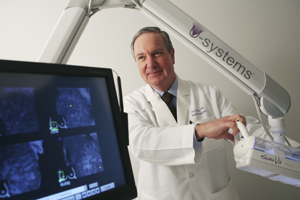Mar 28 2008
The newest technology in breast imaging - a fully automated 3-D breast ultrasound machine - is now in use at UT Southwestern Medical Center's Southwestern Center for Breast Care, the first site in Dallas and Fort Worth to obtain the equipment.
 Dr. Phil Evans, director of the Center for Breast Care, and his clinical staff now offer the newest technology in breast imaging - a fully automated 3-D breast ultrasound machine that uses sound waves to make images of the tissues inside the breast.
Dr. Phil Evans, director of the Center for Breast Care, and his clinical staff now offer the newest technology in breast imaging - a fully automated 3-D breast ultrasound machine that uses sound waves to make images of the tissues inside the breast.
Breast ultrasound is a noninvasive procedure that uses sound waves to make a picture of the tissues inside the breast. It has traditionally been used following mammography in the targeted evaluation of a possible abnormality found at screening or on physical examination. Because of recently reported studies, breast cancer screening utilizing ultrasound for high-risk women is beginning to gain traction.
Dr. Phil Evans, professor of radiology and director of the Center for Breast Care, said there are benefits to adding automated 3-D breast ultrasound to the arsenal of screening methods available to detect breast cancer in high-risk women, particularly those with a strong family history and dense breast tissue on mammography.
The main advantage is that multiple images of breast tissue can be reviewed on a 3-D workstation. Data can be captured in three dimensions as opposed to a flat image, and physicians can review images from any angle, uncovering areas that previously might have remained unseen. They also can review multiple views simultaneously, said Dr. Evans.
With traditional ultrasound, a technologist or physician performs the scan by hand by moving a wandlike instrument called a transducer over the surface of the breast. A transducer directs the high-frequency sound waves to the breast tissue. The problem with human administration, Dr. Evans said, is that no two individuals perform a breast ultrasound exactly the same way every time, so there can be wide variability in results.
“With this automated ultrasound system, the parameters are preset, and each breast is examined in a systemic manner,” he said.
For an automated ultrasound, the patient lies on an exam table and the technologist attaches a cuplike membrane to the scanner to hold the patient's breast in place. The scanner is then placed on the breast and the technologist presses a button to begin the preview scan. This initial scan, which determines the density of the breast in order to set the appropriate imaging parameters, is immediately followed by the actual image acquisition scan, in which 400 to 500 images of each breast are obtained.
The scan itself lasts about 60 seconds, and Dr. Evans emphasized “there's no compression” as with a traditional breast X-ray, or mammogram. The entire procedure takes about 15 minutes.
Once the 3-D ultrasound is complete, the digital data are sent to an independent computer workstation where a radiologist trained in breast imaging can evaluate each image and look for a possible abnormality. The radiologist also can do a virtual rescan, providing even more data to determine the need for a patient to be called back for additional testing. The data can be reviewed immediately or retrieved later.
Dr. Evans said ultrasound is more comfortable than mammography, but mammography should not be eliminated. He said high-risk individuals could alternate between ultrasound and mammography every six months.
“This is in no way meant to replace mammography,” Dr. Evans said. “It's purely an additional tool for women who are high-risk, but their risk is not high enough for magnetic resonance imaging.”
The exam, which is less expensive than a mammogram or an MRI, is covered by some insurance plans. Physicians at the Center for Breast Care will routinely use the automated scan for screening for some patients, but the exam can be requested by anyone, Dr. Evans said.
Breast cancer is the most common cancer among women, excluding non-melanoma skin cancer. About 3 million women in the U.S. are living with the disease, including 2 million who have already been diagnosed and an additional 1 million who are unaware that they have the disease.
In operation since November 2007, the ultrasound machine at UT Southwestern is on the third floor of the Seay Biomedical Building, located on the North Campus at 2201 Inwood Road.